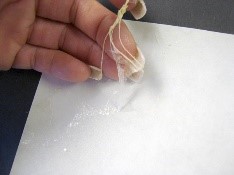 Photo 1
Photo 1
3M PMA is like a wide sheet of ATG that can easily split during application. Check for holes and breaks in the film before final application.
Mounting is accomplished through a variety of methods, including wet, spray, pressure-sensitive, dry, lacing, pinning, starch hinging, and corner pockets. It is important to select the correct size, weight and thickness of any substrate—based on the intended mounting method—which includes the type of adhesive and intended method.
Heat activated and pressure-sensitive products have dominated the mounting market for decades, and there are significant pros and cons to both sizing raw materials—substrate + HA tissue, film or P-S film adhesive—and sizing a ready-to-use adhesive coated product. The time it takes to determine what substrate is required for any mounting job, and the correct adhesive may take more time, than selecting a self-adhesive board.
Matboard
Pressure-sensitive adhesives (PSAs)—pressure-sensitive (P-S), pressure activated (PA)—are available as both films, to be applied to any substrate of choice, or with the PSA already applied to a selected substrate, often referred to as self-adhesive (SA) boards. They are thermoplastics, which require no moisture or heat for application, available as ready-to-use coated substrates, offered to framers as either high or low tack versions. Also referred to as cold mounts, PSA is a tacky substance that bonds to a poster, photo, or digital image at room temperature, with only the application of pressure. They are dry, synthetic adhesives that are clean, easy to use, odorless, use no solvents, and are available on assorted substrates including foamboard, Gatorfoam®, Sintra®, honeycomb panels (Eaglecell®), and aluminum composite material (ACM).
There are also PSA films available with single release liners—rolled 3M 568 Positionable Mounting Adhesive (PMA), Neschen Gudy®, and wide high tack rolls for cold rollers—and double release liners—large flat sheets of Crescent Perfect Mount Film. (photos 1, 2, 3)
 Photo 1
Photo 1
3M PMA is like a wide sheet of ATG that can easily split during application. Check for holes and breaks in the film before final application.
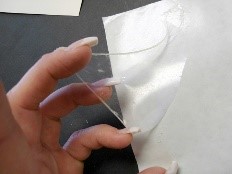 Photo 2
Photo 2
Gudy 870 film will manually apply to a substrate or back of art with little chance of separation.
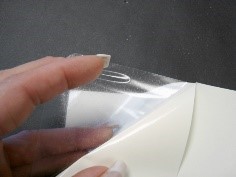 Photo 3
Photo 3
PerfectMount film has two liners and the film has an inner carrier that prevents stretching or breakage.
High, Medium and Low Tack Pressure-Sensitives
There are three levels of tack available with PSAs: high, medium and low tack. High tack is aggressive and most difficult to hand apply since it has no repositioning potential. They immediately grab to a smooth nonporous or coated stock with no forgiveness. Medium tack is the one most frequently used in picture framing. It may be somewhat repositionable during alignment with porous papers, but even repositionable P-S boards will grab more aggressively to a smooth or coated material. Low tack is most often found as a temporary positioning tack or used in preparation for other bonding, as with some HA adhesives or laminates with liners, making them not suitable for the longevity of framing demands.
In our industry there are commercial P-S products labeled HT (high tack) and LT (low tack). Generally, the high tack grabs quickly and may not be repositionable, whereas the low tack—named as a marketing explanation and not to be confused with the description above—offers more repositionability. Samples of HT products include 3A Composites Fome-Cor® HT Quickstik (red liner), Gatorfoam® HT Self-Adhesive, Gilman InSite® Self Adhesive HT (black liner), and KoolTack InstaMount line. Low Tack repositionable boards include Fome-Cor® LT Quickstik (blue liner); Gilman Insite® Self Adhesive LT (green liner), and InstaMount Repositionable Self-Adhesive.
P-S Application Tips
When an image is manually applied with a hand rub to a P-S board it may only activate 25% of the adhesive capability. In order for the adhesive to have a higher percentage of activation it requires burnishing after application or run through high pressure rollers. Even placing in a vacuum frame is not as good as burnishing.
Application and end use temperature effects p-s bond permanence, and moisture is a physical barrier to adhesion and long term bonding. A permanent, high tack pressure-sensitive applied at room temperature may fail at freezing temperatures if placed outside, or in an excessively humid bathroom. Coldness to the touch is an indicator of moisture content in boards making dry storage imperative for p-s materials, if boards are damp, permanence is threatened.
Most P-S boards have inert, stable, neutral pH adhesives applied to a selected substrate requiring weight for 12-24 hours after burnished or rolled application for a fully cured bond.
Other PS Boards
Other popular substrate alternatives such as high density foamboards (Ryno, Jetmount), Sintra (Komatex), Gatorfoam, honeycomb (Crescent notFOAM, Eaglecell), and ACM (Dibond, Competition Plate) are available with either or both HA and P-S adhesive coatings, in some cases by third party companies. Or there is the option of creating your own S-A board by selecting the HT film and substrate of choice and applying it to the board with roller or press, then mounting the art. (photo 4)
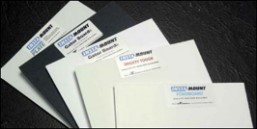 Photo 4
Photo 4
Other heavy-duty InstaMount boards include Competition Plate, Gatorboard.
Heat Activated Adhesives
Dry mount adhesives are easiest to understand when examined by their four basic characteristics. Once the type of bond (permanent or removable); physical composition (tissue-core or film); porosity (breathable or nonbreathable); and acidity level (tissue pH) have been identified, then all adhesives may be compared and matched up. The difference with preadhesived HA boards is not the type of adhesive as much as it is the impact of their elements. HA boards act more like a tissue adhesive that has been applied to a board instead of a carrier.
Heat Activated Boards
Thermal activated adhesives—also known as HA or heat-activated dry mount adhesives—are available as permanent, removable, and reversible boards, with temperatures running from low 130ºF to high of 190ºF. Permanent HA boards bond in the press as all layers reach required bonding temperature, and the bond may only be broken with a chemical solvent.
There are three categories of permanent HA board bonding temperatures: between 180ºF-190ºF with an average vacuum press dwell time of 4 minutes; lower 150ºF-170ºF temperatures with dwell times of 15-30 seconds; and 130ºF, for 15-30 seconds in a mechanical press. Removable HA boards activate as all layers reach temperature in the press, but bond outside the press as they cool under a weight. They have a moderate activation temperature of 150ºF-160ºF with a shorter dwell time of 1-3 minutes plus vacuum draw time. Reversible Kool Tack Preserve Ultra has the same activation temperature of 150ºF as some removable boards, but with a shorter dwell time for 15 seconds to 1 minute in a mechanical press. Reversible boards have a much lighter bond and art may be removed from the substrate and returned to its original state with no adhesive absorption or residue left behind.
HA Application Tips
Basic mounting steps should be: set the temperature and dwell time—dwell time begins after press has reached full draw usually about 30 seconds—and preheat press; check platen and substrate surface for dust and lint; align art face up; cover with release liners or other release material; mount; and cool under a weight. For any board to bond properly it should have full tear strength once fused. That means the top layer of adhesive and surface paper should rip from the board if dry peeled after mounting. (photo 5)
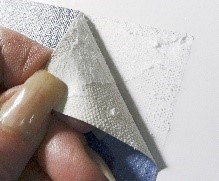 Photo 5
Photo 5
Full tear strength means the top layer of adhesive and surface paper should rip from the board if dry peeled as illustrated with this digitally printed canvas.
Bond strength—tear strength—better identifies permanence because of the subjectivity of what might be meant by permanent. In the case of a PSA, permanent means impossible to remove without destruction of the substrate or mounting, such as with a mailing label. A removable PSA may be removed without harming the substrate in any way or leaving adhesive residue. The act of permanently bonding any art to a backing is never a preservation method, and regardless of how stable and inert any adhesive may be, it is the adhesive absorption into the art is what makes a mounting method non-reversible and non-preservation.
Fabric
Linen and cotton fabrics may also be reinforcement for the relining of aging, disintegrating, or antique art, thus including fabric as a substrate. Artwork, such as vintage movie posters, may be mounted with rice or wheat starch paste, wet glue or dry mount film—depending on item value, and desired conservation treatment. Starch mounting them helps stabilize them while maintaining reversibility if necessary. Relined posters were lithographs printed using oil based inks so water based adhesives do not affect the pigments. Many years ago, HA canvas and linen products used to be available in the framing industry, but today only Drytac still offers HA Artist Canvas—a 10oz, 1-ply bleached cotton canvas—specifically designed for canvas transfers of prints or photos.
Synthetic fabrics may also be selected as a substrate. The unstable nature of these fabrics often makes them light fugitive, allowing them to fade over time, and the acidity level in fabrics varies with dyes, colorants, and some fibers. Fabrics of unknown origin are not the best choice when framing valuable artwork, as they are probably nowhere near conservation level. Neutral pH fabrics of cotton, linen, and canvas are available for wrapping, backing and shadow boxes if needed for preservation framing.
Final Mounting
Preadhesived boards may not be for everyone, but roller laminators continue to gain popularity in today's frame shop due to oversized digital printing, and if production mounting is an element in your market then HA boards might be the answer. Whether HA or SA board is selected, never choose by price. Though cost is definitely a consideration it remains only one of the factors in the equation. Consider roller vs. press, size requirements, weighting and curing time, long term bond permanence, thicknesses and rigidity. It all counts.
END
Copyright © 2023 Chris A Paschke
For more articles on mounting basics look under the mounting section in Articles by Subject.
Additional information on all types of mounting is found in:
The Mounting and Laminating Handbook, Second Edition, 2002,
The Mounting And Laminating Handbook, Third Edition, 2008 and
Creative Mounting, Wrapping, And Laminating, 2000 will teach you everything you need to know about getting the most from your dry mount equipment and materials as an innovative frame designer.
All books are available from Designs Ink Publishing through this website.
Chris A Paschke, CPF GCF
Designs Ink
Designs Ink Publishing
785 Tucker Road, Suite G-183
Tehachapi, CA 93561
P 661-821-2188
chris@designsinkart.com